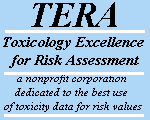|
|
Key References for the Octabromodiphenyl Ether & Pentabromodiphenyl Ether Documents |
|
Breslin,
W., Kirk, H., Zimmer, M. 1989.
Teratogenic Evaluation of Polybromodiphenyl Oxide Mixture in Breysse,
P., Kacergis, J. 2000.
Brominated Flame Retardant End-User Survey Phase I, Final
Report. Submitted to CMA
(BFRIP). Carlson, G.P. 1980b. Induction of Xenobiotic Metabolism in Rats by Brominated Diphenyl Ethers Administered for 90-Days. Toxicology Letters. 6:207-212. Darnerud,
P.O., Eriksen, G. S., Johannesson, T., Larsen, P., Viluksela, M.
2001. Polybrominated
Diphenyl Ethers: Occurrence, Dietary Exposure, and Toxicology.
Environmental Health Perspectives.
109:49-68. Dodder,
N.G., Strandberg, B., Hites, R.A.
2002. Concentrations
and Spatial Variation of Polybrominated Diphenyl Ethers and Several
Organochlorine Compounds in Fishes from the Eriksson, P., Jakobsson, E., Fredriksson, A. 1998. Developmental Neurotoxicity of Brominated Flame-retardents, Polybrominated Diphenyl Ethers and Tetrabromo-bis-phenol A. Organohalogen Compounds. 35: 375-377. Ericksson, P., Viberg, H., Jakobsson, E., Orn, U., Frederiksson, A. 1999. BDE 2,2,4,45-Pentabromodiphenyl Ether Causes Permanent Neurotoxic Effects During a Defined Period of Neonatal Brain Development. Organohalogen Compounds. 40: 333-336. Eriksson, P., Jakobsson, E., Fredriksson, A. 2001. Brominated Flame Retardents: A Novel Class of Developmental Neurotoxicants in Our Environment. Enviornmental Health Perspectives. 109(9): 903-908. Eriksson, P., Viberg, H., Jakobsson, E., et al. 2002. A Brominated Retardent, 2,24,4,5-Pentabromodiphenyl Ether: Uptake, Retention, and Induction of Neurobehavioral Alterations in Mice During a Critical Phaseof Neonatal Brain Development. Toxicological Sciences. 67: 98-103. European
Chemicals Bureau (ECB). 2000.
Health and Safety Executive.
Risk Assessment of Diphenyl Ether, Pentabromo Derivative
(Pentabromodiphenyl Ether). Draft
Final Report, August. 793/93/EEC. European
Chemicals Bureau (ECB). 2002.
Risk Assessment of Diphenyl Ether, Octabromo Derivative.
Final Report, July. Gilbert
, Hale, R. C., La
Guardia, M. J., Harvey, E., Mainor, T. M.
2002. Potential
Role of Fire Retardant-Treated Polyurethane Foam as a Source of
Brominated Diphenyl Ethers to the International Research and Development Corporation (IRDC). 1976. Twenty-eight Day Toxicity Study of Pentabromodiphenyl Ether in Rats. Final Report. Inveresk Research 2001. The In Vitro Percutaneous Absorption of [14C] Tetrabromodiphenyl Oxide (a Surrogate for [14C] Pentabromodiphenyl Oxide) Through Human and Rat Skin. Report Number 19189. Johnson,
A., Olson, N. 2001.
Analysis and Occurrence of Polybrominated Diphenyl Ethers in Juberg,
D.R., Alfano, K., Coughlin, R.J., Thompson, K.M.
2001. An
Observational Study of Object Mouthing Behavior by Young Children.
Pediatrics. 107(1):
135-142 Knoth,
W., Mann, W., Meyer, R., Nebhuth, J.
2002. Polybrominated
Diphenyl Ether in House Dust. Organohalogen
Compounds. 58: 213-216. Rahman,
F., Langford, K. H., Scrimshaw, M.D., Lester, J. N.
2001. Polybrominated
Diphenyl Ether (PBDE) Flame Retardants.
The Science of the Total Environment.
275: 1-17. Ohta,
S., Ishizuka, D., Nishimura, H., Nakao, T., Aozasa, O., Shimidzu, Y.,
Ochiai, F., Kida, T., Nishi, M., Miyata, H.
2002. Comparison
of Polybrominated Diphenyl Ethers in Fish, Vegetables, and Meats and
Levels in Human Milk of Nursing Women in Orn, U., Klasson-Wehler E. 1998. Metabolism of 2,24,4,4-Tetrabromodiphenyl Ether in Rat and Mouse. Xenobiotica. 28:199-211. Palm, A., Cousins, I.T., Mackay, D., Tysklind, M., Metcalfe, C., Alaee, M. 2002. Assessing the Environmental Fate of Chemicals of Emerging Concern: A Case Study of the Polybrominated Diphenyl Ethers. Environmental Pollution. 117: 195-213. Ryan,
J., Patry, B., Mills, P., Beaudoin, N.G.
2002. Recent
Trends in Levels of Brominated Diphenyl Ethers (BDEs) in Human Milk
from Sjφdin,
A., Carlsson, H., Thuresson, K., Sjolin, S., Bergman, Ε., Ostman, C.
2001a. Flame Retardants in Indoor Air at an Electronics
Recycling Plant and at Other Work Environments.
Environmental Science & Technology.
35: 448-454. Strandberg,
B., Dodder, N. G., Basu, Taylor , M.M., Hedge, J.M., DeVito, M.J., Crofton, K.M. 2002. Perinatal Exposure to Polybrominated Diphenyl Ether Mixture (D-71) Disrupts Thyroid Hormones but Not Neurobehavioral Development. The Toxicologist. p. 133. United States Consumer Product Safety Commission (USCPSC). 2002. Response to Petition HP 99-1, Request to Ban PVC in Toys and Other Products Intended for Children Five Years of Age and Under. Health Sciences. August 2002. Viberg, H., Fredriksson, A., Eriksson, P. 2002. Neonatal Exposure to the Brominated Flame Retardent 2,2,4,4,4-Pentabromodiphenyl Ether Causes Altered Susceptibility in the Cholinergic Transmitter System in the Adult Mouse. Toxicological Sciences. 67: 104-107. WIL Research Laboratories. 1986a. A Range-Finding Teratology Study in Rats with DE-79. Study Number WIL-12051. August 25. Wenning,
R.J. 2002.
Uncertainties and Data Needs in Risk Assessment of Three
Commercial Polybrominated Diphenyl Ethers: Probabilistic Exposure
Analysis and Comparison with European Commission Results.
Chemosphere. 46:
779-796. Zhou, T., Ross, D.G., DeVito, M.J., Crofton, K.M. 2001. Effects of Short-Term In Vivo Exposure to Polybrominated Diphenyl Ethers on Thyroid Hormones and Hepatic Enzyme Activities in Weanling Rats. Toxicological Sciences. 61:76-82. Zhou, T.,
|

